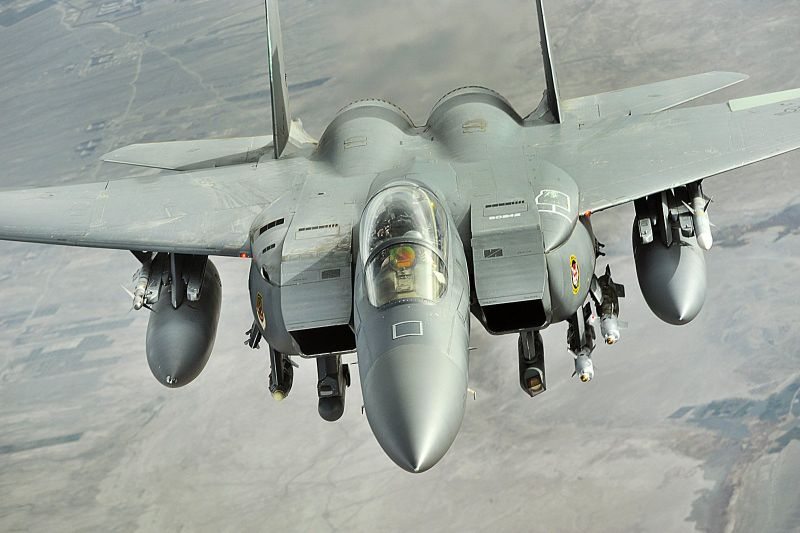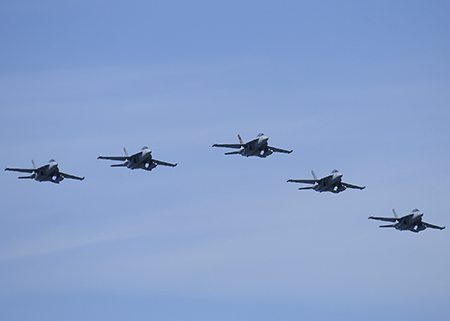Air Force close air support assets played a critical role in the success of Operation Hammer Down II along the Afghanistan-Pakistan border June 25-30.
F-15E Strike Eagles from the 389th Expeditionary Fighter Squadron and F-16 Fighting Falcons from the 555th EFS at Bagram Airfield, Afghanistan, provided 176 consecutive hours of air support and dropped more than 100 bombs in support of the operation.
Operation Hammer Down II was a coalition effort to disrupt insurgents operating and training throughout the Pech Valley area and also continued the expansion of Afghan National Security Forces capabilities through partnered operations.
Coalition Soldiers from the Army’s 3rd Brigade Combat Team, 25th Infantry Division, Task Force Bronco, partnered with Afghan National Army troops and air-assaulted into high ground surrounding the valley. Heavy insurgent fire began the next morning and continued for four days.
As the fight began to develop, it became clear that close air support from the Air Force was going to be critical, not only to the success of the mission, but to saving lives as well.
“There were numbers of occasions where if we hadn’t had (close air support), lives would have been lost or strong points overrun,” said Army Maj. Dan Gibson, the 3rd Brigade Combat Team, 25th Infantry Division brigade fire support officer. “Our ground commanders worked hand-in-hand with Air Force Joint Terminal Attack Controllers to get bombs where we needed them.”
One pilot working closely with the Army to put bombs on target was Lt. Col. Daren Sorenson, the 455th Expeditionary Operations Group deputy commander and F-15E pilot.
“We brought a major advantage through the air,” Sorenson said. “The enemy knows how to adapt their tactics to ground forces and to use the terrain to their advantage, but we brought something they could not counter.”
According to the colonel, the mere sound of jet engines was enough to send insurgents running from the fight.
“Hearing jet noise, you can’t quantify that,” Sorenson said. “Insurgents will run, hide and quit fighting. We’ve received feedback of them saying things like, ‘I’m not fighting today with the planes in the sky.'”
Although the roar of fighters over the battlefield was a powerful presence, it didn’t completely stop enemy efforts to overrun coalition positions. Numerous “danger-close” fire support requests came in frequently to the fighters overhead.
“Communications with our JTACS was very intense,” said Lt. Col. Mark O’Neal, the 389th EFS assistant director of operations and F-15E weapons system officer. “We’d hear shooting in the background as they shouted, ‘We need bombs now!'”
The fighters had to walk a delicate balance of quickly dropping munitions while making sure all the necessary calculations and coordination occurred to ensure bombs did not hit friendly forces.
“There was a period where we dropped seven bombs in a span of 26 minutes, which is a very fast rate … some within 250 meters of our forces,” O’Neal said. “It’s nerve wracking, but when that JTAC comes on the radio and says, ‘Excellent job, not a scratch on friendlies,’ it makes it all worthwhile.”
Capt. Shuan Hoeltje, a 555th EFS F-16 pilot, said overcoming extreme weather and successfully dropping bombs in danger-close scenarios was a surreal experience.
“We were flying near a thunderstorm part of the time and didn’t have good visibility,” Hoeltje said. “We knew we had to take it up a notch with the bad guys so close to our guys. In the end, we were able to effectively deliver responsive and precise airpower.”
While close air support was the tip of the spear in the Air Force component of the fight, Sorenson emphasized that it took a total force effort from the 455th AEW to help coalition forces accomplish the mission.
“Hammer Down is a good example of how almost every squadron in the wing played a part, integrating together to provide a complete support package to the guys on the ground, 24/7,” he said.
From pre-positioned combat search and rescue assets, to maintainers, to intelligence assets, the 455th AEW brought a full spectrum of air support to the battlefield.
In addition to the total force coming together to deliver responsive and precise airpower to ground commanders, Sorenson said Operation Hammer Down II was one of the best examples of the joint force working seamlessly together that he has ever seen.
“Every single time I go on deployment, I see the progress we’ve made as a joint warfighting capability, and it just continues to get better over time,” said the six-time combat veteran. “Hammer Down is such a good example of what we do. We have gotten to the point where it is so joint and so integrated — it’s astounding.”
Sorenson and Hoeltje each talked about the sense of fulfillment they gained from participating in Hammer Down.
“It’s a great feeling,” Hoeltje said. “That’s why we’re out here, to bring that kinetic energy … giving our Army brothers exactly what they want, when they need it.”
Sorenson echoed the junior pilot’s sentiment.
“The job satisfaction is second to none,” Sorenson said. “No matter what I’ve done up to this point, no matter how hard the training was, no matter how long it took, knowing I contributed to someone getting home safely to their family makes it all worthwhile.”
In all, Operation Hammer Down II killed more than 100 insurgents, including four high-value targets. Coalition intelligence officials estimated the achievements of the operation interrupted the enemy’s training capabilities and disrupted them from making coordinated attacks for the remainder of the fighting season.











